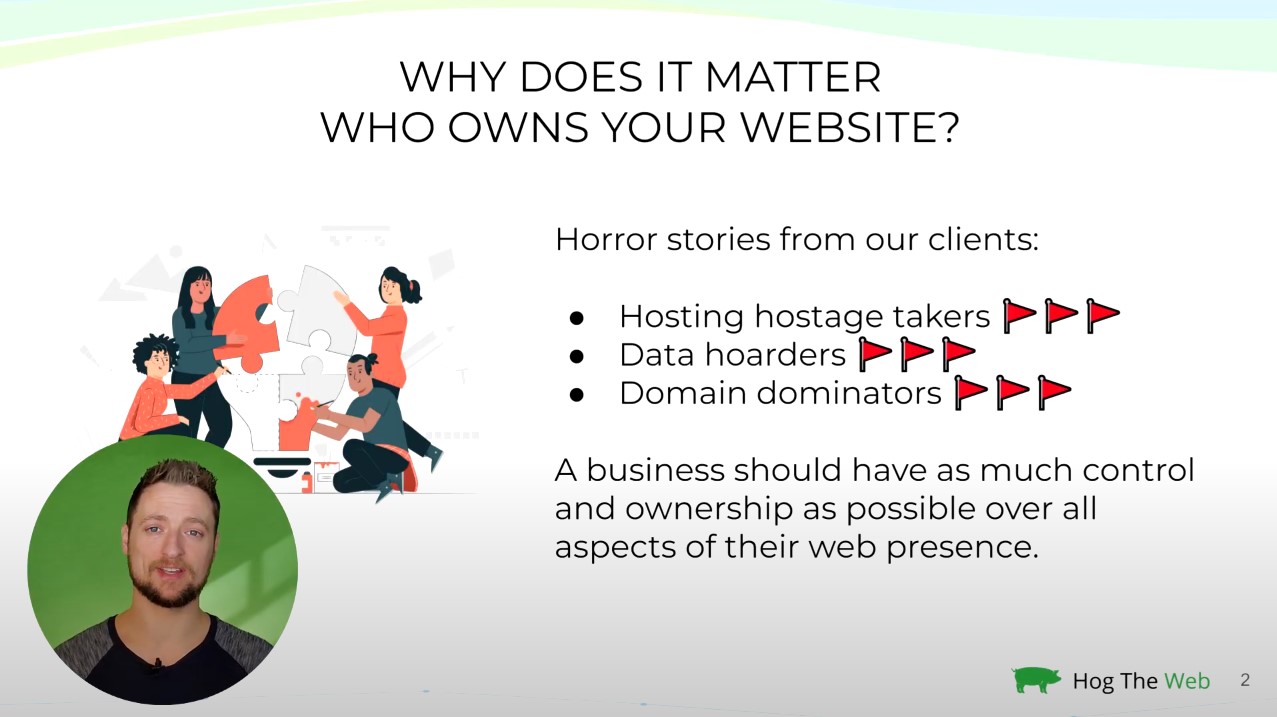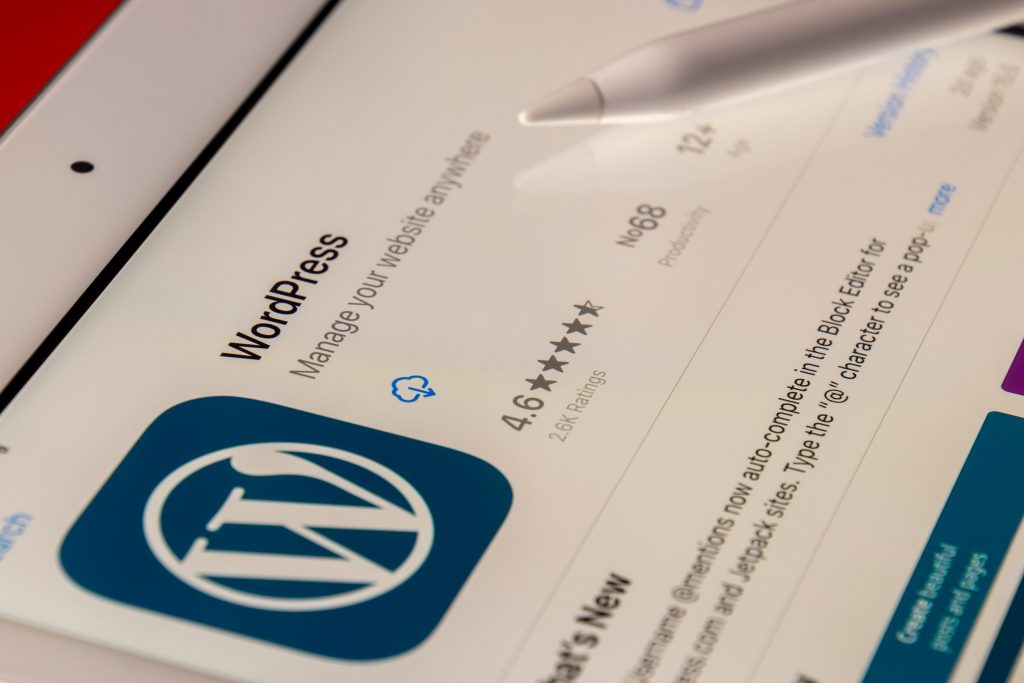WATCH THE VIDEO:
Hey, Levi here again with Hog the Web to help answer the question: Do you own your website? And more importantly, why that question is really important when you’re working with web service providers. First of all, I want to share a few horror stories that we’ve come across.
Hosting Hostage Takers
This is something that comes up fairly often when we’re doing our web design and development work with clients. All too often, what happens is some previous web service provider, maybe it’s a developer, a designer, or paid ads specialist; that person basically takes ownership of certain aspects of a company’s web presence.
When the relationship goes sour, they are unwilling to hand over the keys. This has created some major problems and stress. In one case, we actually had to rebuild a company’s entire website because the old developer wouldn’t give us access to the website so that we could make a copy of it.
Designed by slidesgo / Freepik
It’s not always ill intentions. In one case, it was a graphic designer who recently started doing web design. They didn’t understand how to set up web hosting servers well. They put all their different client’s websites on the same shared server, so they couldn’t grant you access to one company site without granting you access to all these other companies.
Data Hoarders
One of our clients hired a company to do paid ads through Google ads. In this digital marketing company, they created their own custom dashboard to present the ad results and information to the client. That’s great, except that they refused to give the client direct access to the Google Ads account where they were running their ads.
That definitely sent off some big red flags when I heard about that because it clearly seemed like they might be using their own dashboard to manipulate the data. The client should always have complete access and control over all the different web properties. This is our philosophy at Hog the Web. We’re kind of like property managers.
You, the client, have the keys, and you just give us a temporary key. This is so we can go in and make changes and tweak it and manage it. But ultimately, you’re the owner, and that’s how it should be.
Please don’t take any of this advice as legal advice. I’m not a legal professional. Talk to your legal counsel if you have any detailed questions, but I’m just going to share my understanding based on all these different components that go into a website and web presence.
Domain Dominators
Another horror story from a client was when one of the previous developers had purchased their domain for them under that web developer’s own personal account. Because that person may be moved on to something else, it was really difficult and tedious to transfer the domain and give the client ownership.
These are all red flags that we look out for, and why we at Hog the Web look out for a client’s best interests; whether or not they decide to continue working with us. We want to make sure that we’re not holding them hostage in any kind of way. Although most of our clients do choose to keep working with us for years, but not because we forced them to.
Important Components for Your Web Presence
A web presence is made up of many different components. Let’s start breaking that down and look at some of the details.
Your Domain
First is your domain, like my company.com.
Hosting
Next is your hosting. That’s the server that’s holding your website, so anyone that’s visiting your site is connecting to it. It’s serving up the data and content of your website to every person who visits.
CMS
There is also a Content Management System or CMS. The most common example is WordPress. You can think about this as the operating system of your website. Another reason why we recommend WordPress is that it’s so easy to transfer.
Some web design companies have their own proprietary content management system that they’ve custom coded for their clients. While it may create a very nice website, the problem is that there’s no way to transfer that if the relationship sours.
There’s no way to transfer that to another company. Another company will be unable to maintain or manage this completely proprietary website, and they’ll have to build it from scratch. That’s not the case with WordPress because WordPress is so universal and flexible.
Add Ons
Next are add-ons. These are little chunks of software that add features. The common ones are pop-up plugins to add pop-up functionality or to integrate your mailing list.
Custom Code
Custom code is not always part of every website, but sometimes a client might want a very unique particular effect. Let me show you an example.
This website was built for Imhoff painting. Most of what we did here didn’t require any custom code. That’s a good thing because it means that it’s easy to maintain. However, certain very unique effects, like this radiating play button and the scrolling icon, weren’t built-in aspects. It’s just a small piece of custom code that we came up with.
Design
The design is next. That’s going to be the entire layout of what is pictured in the example below. The fonts, button styles, dividers, and all these graphical elements.
All of that is part of the web design. That’s exactly what we do when we design a website. We come up with a very cohesive and appealing look.
Content
Next, you have the content, which is the words, video, and/or images.
Social Profiles
Getting beyond the website, you’ve got social profiles. So there’s LinkedIn, Facebook, Instagram, and more. There are also directories like Google My Business, Yahoo, and other profile sites.
Analytics Data
Finally, you have your analytics data. So Google Analytics is the most common one. Other ones, like Hot Jar basically collect all the analytics data from your website or other web profiles. That data is usually held on third-party servers; it’s not built into the website itself.
Who Owns What?
Now that we understand all the different pieces and components let’s talk about who owns what. Here are the things that you can’t really own as a business owner but should have control over.
Your domain, because the domain registrar actually owns the domain, and you just pay a registration fee to them yearly.
Second is your web hosting server. Some companies have their own web hosting server and have a computer sitting in a closet somewhere. But for most small businesses, and even medium-sized businesses, that’s not necessary; they just rent web server space from a web hosting company such as SiteGround, or GoDaddy or WP Engine, or other ones like this.
Next is the content management system, WordPress, and the plugins and themes. That software is owned by the developers.
They usually give you a license or key to use it. Sometimes it’s an open-source license; other times, it’s more limited, and sometimes, it’s a paid license. Similarly, with your social media profiles and your analytics data; the company technically owns that, i.e., Facebook or Google, but they’re just giving you access to use it. Still, you should always have control over those things.
What you should own is anything that’s created custom for you as a work-for-hire. For example, the design of your website and the content on your website. Typically, you would provide the website’s content to a web designer; that’d be the text, images, and maybe videos, as well as your logo and other content.
You should already have ownership of all of those things. Also, any custom code snippets that are written specifically for your project or for your website should also be transferred to you.
Hopefully, that answers your question of who owns your website and, more importantly, why it’s important to own it, and have the keys over all the different components that make up your web presence. Thank you for reading or tuning in today. If you have any questions at all, feel free to reach out to Hog the Web. We’re always here to help and lend our expertise. Take care.

Levi is the Founder & CEO of Hog The Web, a web design and WordPress services company delivering high-performance websites since 2015. With over a decade of hands-on experience in building, maintaining, and securing websites, Levi leads his team with a focus on craftsmanship, reliability, and long-term client partnerships. Outside the web world, he’s passionate about nature, sustainable living, and giving back through local non-profits and youth education.















Thank you very much for this article. I experienced the same problem with the old website of a family member. I could not believe it, but it seems to be a common practice by developers, freelancers, and agencies to first use clients’ lack of knowledge to take good money for something they cannot control and afterward to punish or blackmail them when they want to leave. Basically, It took me 6 months and a lot of time and energy to gain the ownership of the complete website! I wish I had your checklist back then ;-).